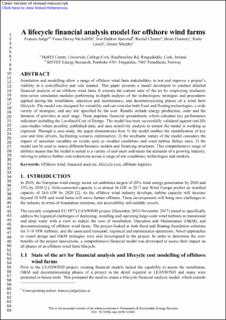| dc.contributor.author | Judge, Frances | |
| dc.contributor.author | McAuliffe, Fiona Devoy | |
| dc.contributor.author | Sperstad, Iver Bakken | |
| dc.contributor.author | Chester, Rachel | |
| dc.contributor.author | Flannery, Brian | |
| dc.contributor.author | Lynch, Katie | |
| dc.contributor.author | Murphy, Jimmy | |
| dc.date.accessioned | 2020-08-25T09:11:15Z | |
| dc.date.available | 2020-08-25T09:11:15Z | |
| dc.date.created | 2019-01-15T10:29:47Z | |
| dc.date.issued | 2019 | |
| dc.identifier.citation | Renewable & Sustainable Energy Reviews. 2019, 109 370-383. | en_US |
| dc.identifier.issn | 1364-0321 | |
| dc.identifier.uri | https://hdl.handle.net/11250/2673839 | |
| dc.description.abstract | Simulation and modelling allow a range of offshore wind farm stakeholders to test and improve a project's viability in a cost-effective and safe manner. This paper presents a model developed to conduct detailed financial analysis of an offshore wind farm. It extends the current state of the art by employing stochastic time-series simulation modules performing in-depth analysis of the technologies, strategies and procedures applied during the installation, operation and maintenance, and decommissioning phases of a wind farm lifecycle. The model was designed for versatility and can consider both fixed and floating technologies, a wide variety of strategies, and any site specified by the user. Results include energy production, costs and the duration of activities at each stage. These populate financial spreadsheets, which calculate key performance indicators including the Levelised Cost of Energy. The model has been successfully validated against real-life case-studies where possible; published data; and uses sensitivity analysis to ensure the model is working as expected. Through a case-study, the paper demonstrates how 1) the model enables the identification of key cost and time drivers, facilitating scenario optimisation; 2) the stochastic nature of the model considers the impact of uncertain variables on results such as weather conditions and wind turbine failure rates; 3) the model can be used to assess different business models and financing structures. This comprehensive range of abilities means that the model is suited to a variety of end-users and meets the demands of a growing industry, striving to achieve further cost-reductions across a range of site conditions, technologies and markets. | en_US |
| dc.description.abstract | A lifecycle financial analysis model for offshore wind farms | en_US |
| dc.language.iso | eng | en_US |
| dc.publisher | Elsevier | en_US |
| dc.rights | Attribution-NonCommercial-NoDerivatives 4.0 Internasjonal | * |
| dc.rights.uri | http://creativecommons.org/licenses/by-nc-nd/4.0/deed.no | * |
| dc.title | A lifecycle financial analysis model for offshore wind farms | en_US |
| dc.type | Journal article | en_US |
| dc.type | Peer reviewed | en_US |
| dc.description.version | acceptedVersion | en_US |
| dc.source.pagenumber | 370-383 | en_US |
| dc.source.volume | 109 | en_US |
| dc.source.journal | Renewable & Sustainable Energy Reviews | en_US |
| dc.identifier.doi | 10.1016/j.rser.2018.12.045 | |
| dc.identifier.cristin | 1656874 | |
| dc.relation.project | EC/FP7/614020 | en_US |
| cristin.unitcode | 7548,50,0,0 | |
| cristin.unitname | Energisystemer | |
| cristin.ispublished | true | |
| cristin.fulltext | postprint | |
| cristin.qualitycode | 1 | |

